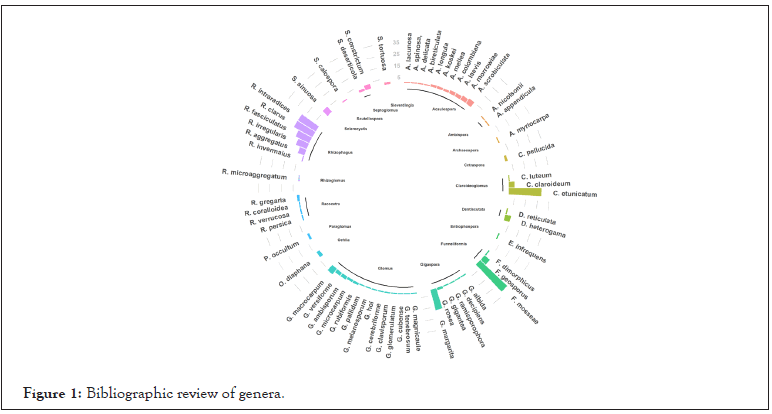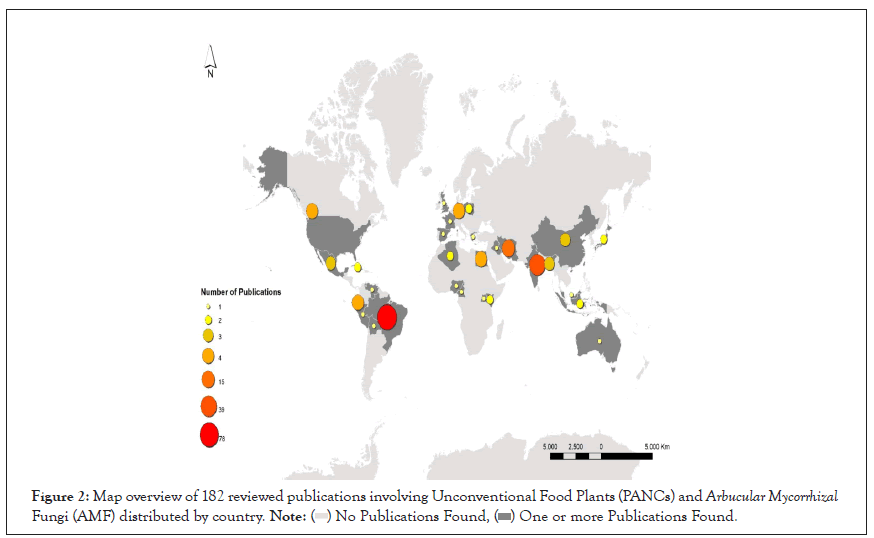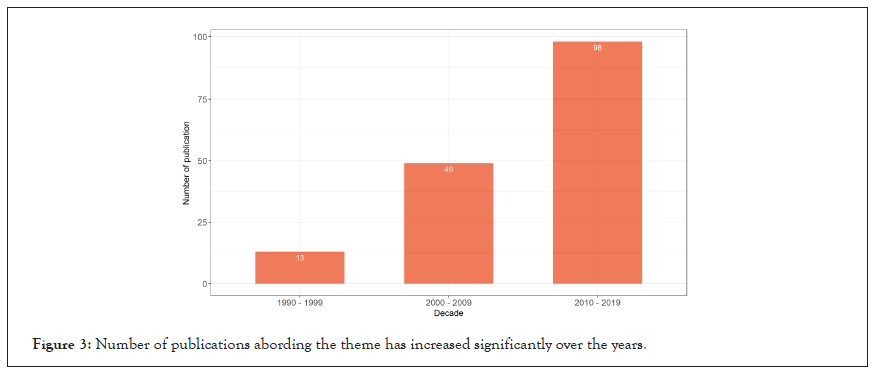Fungal Genomics & Biology
Open Access
ISSN: 2165-8056
ISSN: 2165-8056
Review Article - (2022)Volume 12, Issue 4
The obligatory mutualistic symbiosis between arbuscular mycorrhizal fungi (AMF), Glomeromycota phylum, and plant roots is a relationship present in most vascular plant families in different ecosystems. AMFs collaborate in the absorption of water and mineral nutrients while the host plant transfers compounds resulting from photosynthesis to the fungi, enabling its survival. The acronym PANC–Non- Conventional Food Plants, refers to plant species or parts of them, which are edible. These plants occur spontaneously or through cultivation and are not part of the eating habits of most of the population. PANC are often found in agroforestry systems; complex environments, with more ecological interactions including AMFs and more balanced when compared to monocultures, eliminating the use of fertilizers and chemical pesticides. The objective of this study was to carry out a bibliographical survey on mycorrhizal associations with PANC species. The study consisted of a literature review based on the use of CAPES, Scholar Google and SciELO journal platforms, in a search over a period of 31 years (Jan/1990 to Jun/2021). The literature review allowed selecting 45 PANC species, distributed in 29 families. In total, 182 publications were found that addressed the occurrence of AMF in 36 PANC species, whether natural or from inoculation in experiments, analyzing soil and/or roots. The 182 studies were distributed in 29 countries around the world. The most cited AMF genera were Rhizophagus, Funneliformis and Claroideoglomus, which involved the following, mainly species: Funneliformis mosseae, Claroideoglomus etunicatum, Rhizophagus clarus, R. intraradices, R. fasciculatus and R. irregularis. Regarding species diversity by genera, the main ones were Glomus and Acaulospora, with 14 and 11 species each, respectively. Thus, it was possible to systematize the knowledge about the occurrence and possible benefits of AMFs in PANC species, an area with little information available of great importance for the maintenance and sustainability of agroforestry systems.
Glomeromycota phylum; Mycorrhiza; Plantae kingdom; Tropical ecosystem
In the Plantae kingdom, over millions of years, plants evolved, developing mechanisms and ecological relationships that favored their establishment, adaptation, and survival on the terrestrial environment [1,2]. One of these relationships is the obligatory mutualistic symbiosis between arbuscular mycorrhizal fungi (AMF), belonging to the Phylum Glomeromycota, and plant roots, called arbuscular mycorrhiza [3]. The efficiency of this symbiosis is proven by the presence of these fungi in specimens of more than 70% of vascular plant families in natural and agricultural ecosystems [4,5], bringing benefits to growth and nutrient and water absorption. Furthermore, when combined with mycorrhizae, host plants have greater resistance to biotic and abiotic factors [6], and better-withstanding situations of water stress [7], phytopathogen attacks [8], low fertility soils [9], and toxic metals contamination [10], for example. In addition, there is the possibility of employing AMFs aiming at increasing productivity and reducing the use of chemical fertilizers. Therefore, AMFs play a role of both economic and ecological importance [11].
AMFs are obligate biotrophs, collaborating with the absorption of water and mineral nutrients while, in return, host plants transfer the photoassimilates to the fungus, enabling its survival [2]. They can be detected internally in plant roots, through their arbuscules, and vesicles, and by the colonization of hyphae or close to the roots, by their hyphae and spores. These fungi can be identified through taxonomy based primarily on spore morphology, or molecular biology [12].
The acronym PANC, in Portuguese, Plantas Alimentícias Não Convencionais–Non-Conventional Food Plants, refers to plant species or parts thereof (fruits, leaves, flowers, roots, rhizomes, seeds, stem) that are edible, occur spontaneously or through cultivation, and are not part of eating habits of most of the population. Usually referred to as weed, “bush” or invasive species, by those who are unaware of their nutritional potential, in addition to their cooking methods [13,14]. PANC, as well as mycorrhizal fungi, are widely distributed in different environments [15,16] playing an important role in natural and agricultural ecosystems [17,18]. In addition, many PANC have medicinal properties, and their bioactive compounds provide benefits to consumer health [16-19], as is the case of purslane (Portulaca oleracea L). Therefore, the use of these plant species brings benefits not only to health, promoting a richer and healthier diet, but also enabling crops with high genetic variability, adaptation to different environments, and low environmental impact [14], respecting seasonality, regionality and the non-use of pesticides in favor of sustainable agriculture [13,20,21]. In short, both PANC and AMF can play important roles in environmental recoveries, such as in the generation of biodiversity and maintaining environmental quality.
Some studies have already evaluated the colonization of mycorrhizal fungi in PANC, as in the case of Acmella oleracea (L.) R.K.Jansen) [22], Plantago australis Lam. [22], Spondias tuberosa Arruda [23], and Portulaca oleracea L. [24-28]. Nonetheless, more studies are needed to address a better understanding of the association between PANCS and AMF. It is estimated that there are 12,500 to 75,000 species of potential food plants in the world [29-31]. In addition, up to now, it is estimated that there are more than 3,000 PANC species covering more than 150 families [13], but this value can vary from 6,000 to 10,000 species not yet identified. On the other hand, when it comes to arbuscular mycorrhizal fungi it is an estimated diversity between 37,000 and 78,000 species [32]. Currently, 323 species belonging to 11 families are described [33].
As there are many interactions and possibilities to be studied, our hypotheses are i) most PANC have the potential to be associated with AMFs; ii) More than one AMF species has associative potential per plant species; iii) The AMFs in PANC have a beneficial effect on their development and ecosystems. The present study aimed to conduct a bibliographic survey to relate the potential for interaction between arbuscular mycorrhizal fungi and unconventional food plants occurring in Brazilian Atlantic Forest, expanding to interactions between these organisms published around the world.
The literature review was carried out in two steps, through search and selection of PANC species that occur in agroforestry systems in Rio de Janeiro State, and the pursuit for publications of the selected species developing association with the AMF worldwide.
For the selection of the PANC species a search was carried out through the electronic libraries such as CAPES, SciELO and Google Scholar using the keywords: "Rio de Janeiro", "RJ" or "Atlantic Forest", " Agroforestry Systems”, “Agroforestry”, seeking to obtain information regarding the species present in the AS along with the terms “Unconventional Food Plants” or “PANC”. The acquired data was categorized in a database.
The theoretical reference survey was carried out by searching for national and international articles, abstracts, thesis, books, and dissertations in the same electronic libraries. The keywords used to help investigation this time were "Arbuscular Mycorrhizal Fungi", “AMF", "Unconventional Food Plants”, “Edible weeds”, “PANC”, “Malezas Comestibles”, “Buenezas Comestibles” and “Edible weeds”. Beyond that, each species discovered on the first step search, were used separately along with “Arbuscular Mycorrhizal Fungi” because in many cases the species were not referred to as PANC. In that way, studies citing AMF and PANC species from agroforestry systems of the Brazilian Atlantic Forest were selected regardless of considering any species for their food and nutritional potential, seeking data on the presence or absence of AMF species, whether natural or artificial, from inoculation in experiments.
The AMF species were checked on the AMF-Phylogeny website [34] and when necessary, the most recent nomenclature indicated by the website for each species was used. In case of PANC species, the 45 species had their occurrence in Brazil checked, through REFLORA-JBRJ [35,36]. Only 6 of them weren’t found, being Schinus terebinthifolius Raddi, Vernonanthura phosphorica (Vell.) H.Rob., Cordia verbenacea DC., Cnidoscolus aconitifolius (Mill.) I.M. Johnst, Stachys byzantina K.Koch, and Hibiscus sabdariffa L. However, their occurrence in Brazil was confirmed in the books “Plantas Alimentícias Não Convencionais (PANC) no Brazil” and “Local Food Plants of Brazil”, except for Cordia verbenacea DC., which did not appear in any of the searches. Just like in the case of AMFs, when not found in the searches, their synonymous scientific names were used.
The criteria for the inclusion of publications in the survey were the following: containing information on the occurrence of arbuscular mycorrhizal fungi in species considered to be one of the unconventional food plants selected in the preliminary survey and having a publication date from the year 1990 forward, which means, publications from the last 31 years (Jan/1990 to Jun/2021) were collected.
Among the 45 species reviewed one or more publications on the topic were found for 36 of them. These species in which AMF studies were not found belong to distinct botanical families. Among the nine PANC species of which no publications related to arbuscular mycorrhizal fungi were found, the Xanthosoma taioba E.G.Gonç. (Taioba) was a curious case since it is one of the most prominent PANC, although all studies developed with this famous plant, none of them studied its relationship with AMF. According to the literature, there are some plant families considered non-mycorrhizal, that is, where colonization is not effective, such as Amaranthaceae, Capparidaceae, Chenopodiaceae, Brassicaceae, Calophyllaceae, Caryophyllaceae, Juncaceae, Papaveraceae, Portulacaceae, Polygonaceae, Rubiaceae and Zygophyllaceae [4,25,37-40]. Among the 45 selected species, some of them are part of these groups of plant families, they are Alternanthera sessilis (L.) R.Br. (Amaranthaceae), Amaranthus deflexus L. (Amaranthaceae), Brassica juncea (L.) Czern. (Brassicaceae), Rumex acetosa L. (Polygonaceae), Rumex obtusifolius L. (Polygonaceae), Portulaca oleracea L. (Portulacaceae).
Curiously, of the nine studies citing the species Alternanthera sessilis (L.) R.Br., six indicated the presence of AMF species and three indicated their absence. Only one study was found with Amaranthus deflexus L, where the absence of mycorrhizal association was indicated. In relation to Brassica juncea (L.) Czern, the two publications where this species was mentioned were positive for the presence of AMF. The species Rumex acetosa L. was also positive, with the presence of AMF in all five studies found. As for the Rumex obtusifolius L, among the three studies found, one of them indicated the absence of AMF. Finally, Portulaca oleracea L. had twenty studies found, where only three indicated the absence of AMF.
The absence of AMF was also reported in some studies in species that are not part of plant families traditionally considered nonmycorrhizal, they are: Basella alba L. (Basellaceae) and Hymenaea courbaril L. (Fabaceae), which had respectively 2/5 and 7/16 publications indicating the absence of mycorrhizal association.
It is important to point out that no distinction was made regarding the method used to analyze the occurrence of AMF, that is, the literature review included publications made from the analysis of soil and/or plant roots.
The fact that we found 50% of non-native PANCs species with potential to be associated with mycorrhiza in Brazil shows their possible use in other regions of the world, especially in the tropics, where there was a greater concentration of studies. AMF are particularly important in tropical regions where soils usually present low fertility and mycorrhizal is thought to play a crucial role for growth, survival and development of plant species [40].
As Figure 1 showed, the genera Glomus and Acaulospora were the most diverse during the bibliographic review conducted; however, the genera with major number of publications were Rhizophagus, Funneliformis and Claroideoglomus. It is believed that this result was because a large number of studies deal with the use of AMF in experiments from inoculation, thus, in most cases there is a prioritization of some species already widely studied, as for example, Rhizophagus clarus in Brazil, which contributed to the increase of this number.

Figure 1: Bibliographic review of genera.
Based on the survey of PANC present in the agroforestry systems of the state of Rio de Janeiro, Brazil, the occurrence of 45 PANC species was recorded, distributed in 29 families. According to the established search criteria, a total of 182 publications were selected, distributed in 29 different countries, all which mentioned some relationship between the PANC species selected for research with AMF (Figure 2). The complete list of selected works can be found in Table S1. It was noted that the number of publications abording the theme has increased significantly over the years (Figure 3).

Figure 2: Map overview of 182 reviewed publications involving Unconventional Food Plants (PANCs) and Arbucular Mycorrhizal Fungi (AMF) distributed by country. Note:  No Publications Found,
No Publications Found,  One or more Publications Found.
One or more Publications Found.

Figure 3: Number of publications abording the theme has increased significantly over the years.
The number of publications per plant species ranged from 1 to 26. The most expressive species during the search were Schinus terebinthifolius Raddi (n=26 publications), Cajanus cajan (L.) Huth (n=20), Portulaca oleracea L. (n=20) and Hymenaea courbaril L (n=16) Supplementary Table 1. Meanwhile, no studies related to the topic were found for 9 species, which means that 36 out of 45 had at least one study on the topic. The nine species that were not mentioned in studies with mycorrhiza were: Eryngium foetidum L. (Apiaceae), Xanthosoma taioba E.G.Gonç. (Araceae), Erechtites valerianifolius (Link ex Spreng.) DC. (Asteraceae), Drymaria cordata (L.) Willd. ex Roem. and Schult. (Caryophyllaceae), Tripogandra diuretica (Mart.) Handlos (Commelinaceae), Costus amazonicus (Loes.) J.F.Macbr. (Costaceae), Cnidoscolus aconitifolius (Mill.) I.M. Johnst (Euphorbiaceae), Psidium acutangulum DC. (Myrtaceae) and Boehmeria caudata Sw. (Urticaceae).
The origin status of 36 PANCs consulted at the database Flora e Funga (2022) [41] showed that 50% were native from Brazil; 25% were naturalized and 25% were cultivated.
Regarding the natural occurrence or artificial (inoculation) of AMF in PANC, in one hundred publications was not possible to identify AMF species, only their presence. Thus, they were marked in the Supplementary Table 1 as “unspecified”. In case of publications in which the PANC-AMF relationship was studied but the fungi species was not found, they appear in Supplementary Table 1 as “absent”, totalizing 17 cases. Interestingly, only one plant species, Amaranthus deflexus, were reported as only absent. The AMF species corresponded to a total of 19 genera and 63 species. The number of times each species was cited is presented at Table S2. Regarding the frequency of genera occurrence in the reviewed publications, Rhizophagus, Funneliformis and Claroideoglomus stood out. Regarding number of species by genera, Glomus (n=14) and Acaulospora (n=11) were the main ones (Figure 3). According to this survey, it was possible to notice that most studies do not specify AMF, although dealing with mycorrhization and its benefits for plants.
The advances achieved with this study translate into greater knowledge of the studies published so far on both subjects, bringing together a range of publications that allowed the systematization of knowledge in the area of PANC and arbuscular mycorrhizal associations. It was possible to find studies that reported the possible benefits of arbuscular mycorrhizal fungi in unconventional food plant species, specially growing mineral nutrition, and an area with little information available. It is believed that it is necessary to develop actions and strategies that encourage the use of PANC and FMAs by farmers, which can be allies in the restoration of environments, complementing their profit and also promoting greater environmental and nutritional security. Finally, a new stage in this study is proposed, which would consist of visiting spots with the presence of natural occurrence of PANC species and performing soil and root collections and analysis, in order to examine the presence and diversity of AMFs association at the field.
We are thankful to Scientific Initiation scholarship from DPq/PROPGPI of Federal University of Rio de Janeiro State (UNIRIO). We thank E.M.R da Silva (Embrapa Agrobiologia) and A.C.A.A Dias (UFPA) for their critical suggestions during the SI defense presentation.
There is no conflict of interest.
Citation: da Costa LD, Rocha GS, Tsai SM, Patreze CM (2022) Arbuscular Mycorrhizal Fungi in Unconventional Food Plants that Occur in Agroforestry Systems of Brazilian Atlantic Forest. Fungal Genom Biol. 12:194.
Received: 30-Jun-2022, Manuscript No. FGB-22-18172; Editor assigned: 04-Jul-2022, Pre QC No. FGB-22-18172 (PQ); Reviewed: 18-Jul-2022, QC No. FGB-22-18172; Revised: 25-Jul-2022, Manuscript No. FGB-22-18172 (R); Published: 02-Aug-2022 , DOI: 10.35841/2165-8056.22.12.194
Copyright: © 2022 da Costa LD, et al. This is an open-access article distributed under the terms of the Creative Commons Attribution License, which permits unrestricted use, distribution, and reproduction in any medium, provided the original author and source are credited.